
James Gordon Bennett Jr. was publisher of the New York Herald, founded by his father, James Gordon Bennett Sr. (1795–1872), who emigrated from Scotland. He was generally known as Gordon Bennett to distinguish him from his father. Among his many sports-related accomplishments he organized both the first polo match and the first tennis match in the United States, and he personally won the first trans-oceanic yacht race. He sponsored explorers including Henry Morton Stanley's trip to Africa to find David Livingstone, and the ill-fated USS Jeannette attempt on the North Pole.

USS Hope was a 19th-century wooden yacht schooner, designed and built in 1861 by Henry Steers for Captain Thomas B. Ives of Providence, Rhode Island. She was acquired by the Union Navy during the American Civil War. She was placed into service as a gunboat assigned to support the fleet blockading the ports of the Confederate States of America. However, at times, Hope was assigned extra tasks, such as that of a dispatch boat, supply runner and salvage ship. She was a pilot boat from 1866 to 1891 and in 1891 she was replaced by the Herman Oelrichs, when the Hope was wrecked ashore the Sandy Hook Point.

Samuel Havre Pine, was a 19th-century American ship designer and builder located in Greenpoint, Brooklyn. He built the racing yacht Enchantress as well as many sailing schooners and yachts; steam yachts; and steamships.
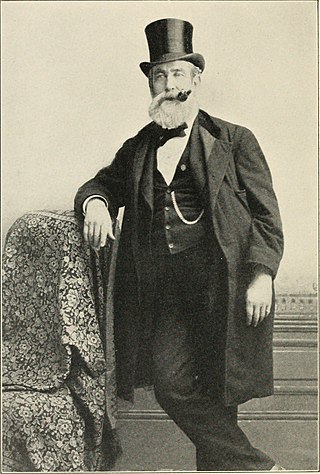
Electus Comfort was a 19th-century Sandy Hook pilot, in active pilot service for 42 years. He was known as the "Beau Brummell of the Sea". He was the captain for the 19th-century Sandy Hook pilot boat Joseph F. Loubat, No. 16.

Robert "Bob" Fish was known as the oldest and most successful of the 19th-century American yacht modelers and shipbuilders. He was well known for remodeling of the Sappho that won 3 successive international races.
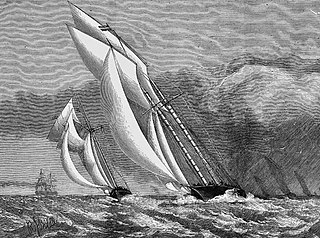
The Enchantress was a 19th-century racing yacht, winner of several national and international Cups including the Royal Yacht Squadron's 53-mile (85 km) regatta around the Le Havre to Southampton, and the New York Yacht Club's 140-mile (230 km) regatta from Owl's Head Point to Sandy Hook Lightship. She was designed by Robert Fish for George L. Lorillard.
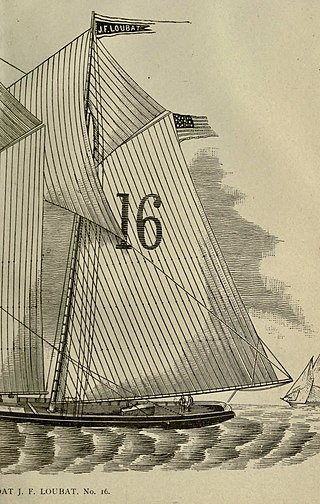
The Joseph F. Loubat was a 19th-century Sandy Hook pilot boat built in 1880 at the Jacob S. Ellis shipyard in Tottenville, Staten Island. She was the largest of the pilot-boats in the Sandy Hook service. In 1896 she was one of the last pilot-boats that were sold in an age of steam and electricity.

The Thomas S. Negus was a 19th-century two-masted Sandy Hook pilot boat, built by C. & R. Poillon shipyard in Brooklyn in 1873 for the New Jersey maritime pilots. She was built to replace the pilot boat Jane, No. 1, which sank in early 1873. She was the winner of a $1,000 prize at the Cape May Regatta in 1873. She was named for Thomas S. Negus, president of the N. J. Pilots' Commissioners. In 1897, she left the pilot service to prospect for gold during the Klondike Gold Rush.

The Widgeon was a 19th-century yacht and Sandy Hook pilot boat, built in 1855 by James R. & George Steers for Daniel Edgar of the New York Yacht Club and designed by George Steers. She came in 17th in an unsuccessful America’s Cup defense in 1870. Widgeon was sold in 1871 to a group of New York pilots to replace the John D. Jones, which sank in a collision with the steamer City of Washington. New York pilots condemned the Widgeon as unseaworthy in 1879, which sparked a fight for steam pilot-boat service. In 1883 a decision was affirmed by the Supreme Court and the Board of Commissioners of Pilots that pilot boats could be "propelled" by steam.
The David Mitchell was a 19th century Sandy Hook pilot boat built in 1846 at Baltimore, Maryland, for a group of New York Pilots. She was launched at the John A. Robb shipyard in East Baltimore. She was sold to the Pensacola, Florida pilot fleet in 1875.

The Christian Bergh was a 19th-century Sandy Hook pilot boat built in 1851 at the Westervelt & Co. shipyard. She later became a Pennsylvania pilot boat until her service ended in 1886 when she became an oyster boat in the Delaware Bay. She was named after Christian Bergh a prominent shipbuilder in New York and a close friend of Jacob Westervelt.

The James M. Waterbury was a 19th-century Sandy Hook pilot boat built in 1843, at Williamsburgh, Brooklyn for a group of New York Pilots. She helped on many of the rescues along the New York Harbor. One of last reports of the James M. Waterbury was in 1867 when seaman James Roach fell overboard and was drowned off Fire Island.

The Centennial was a 19th-century wood pilot boat built in 1876 by Robert Crosbie and designed by Boston designer Dennison J. Lawlor for New York and New Jersey pilots. She was one of the pilot-boats that survived the Great Blizzard of 1888. By 1898, in the age of steam, she was the last pilot boat left in the fleet; then sold in 1898 to a group in Montego Bay, Jamaica.

Edmund Blunt was a 19th-century New York pilot boat built in 1858 by Edward F. Williams for the New York Pilots. She helped transport New York City maritime pilots between inbound or outbound ships coming into the New York Harbor. She survived the Great Blizzard of 1888. In the age of steam, the Blunt along with other pilot boats, were replaced with steamboats. She was built to replace the Jacob L. Westervelt, which sank in 1857.
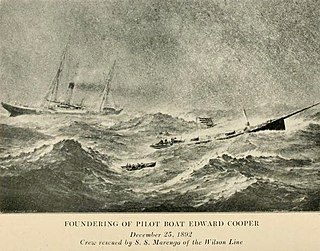
The Edward Cooper was a 19th-century Sandy Hook pilot boat, built in 1879 for New York Pilots at Greenpoint, Brooklyn. She was named in honor of the Mayor of New York City. The Edward Cooper helped transport New York City maritime pilots between inbound or outbound ships coming into the New York Harbor. She survived the Great Blizzard of 1888. In 1892, the Cooper sank in a snowstorm and was replaced by the Joseph Pulitzer in 1894.

The Mary E. Fish was a 19th-century Sandy Hook pilot boat, built at the Edward F. Williams shipyard of Greenpoint, Brooklyn in 1861 for Richard Brown and the New York Pilots. She was built to replace the Mary Taylor. The Fish was hit and sank by the schooner Frank Harrington in 1885 and replaced by the David Carll.
The James Gordon Bennett was a 19th-century two-masted pilot boat, built in 1870 at the Lawrence & Foulks shipyard. She was named in honor of James Gordon Bennett, Jr., publisher of the New York Herald. She went ashore in 1893 and was rebuilt at the C. & R. Poillon shipyard. In 1897, the James Gordon Bennett was bought by Miller J. Morse of the Atlantic Yacht Club and made into a yacht. He changed her name to Hermit. The New Jersey pilots purchased her in 1901, to replace the David T. Leahy, that was run down by the steamship Alene. The Hermit sank in 1906, when the steamship Monterey ran into her.
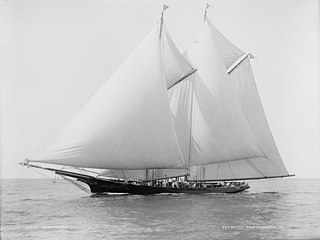
The Dauntless was a 19th-century wooden yacht schooner, designed and built in 1866 by Forsyth & Morgan at Mystic Bridge, Connecticut, and owned and sailed by noted yachtsmen, among them James Gordon Bennett Jr. and Caldwell Hart Colt. She was first called the L'Hirondelle and later renamed the Dauntless. The Dauntless was in three Trans-Atlantic matches for the New York Yacht Club. She came in fourth in an unsuccessful America’s Cup defense in 1870.
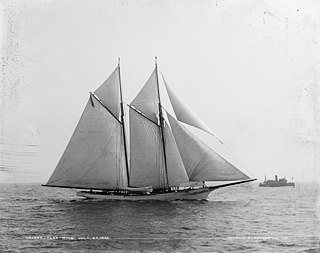
The Fleetwing was a 19th-century wooden yacht schooner, built in 1865 by Joseph D. Van Deusen and owned by yachtsman George Archer Osgood. She was one of the fastest yachts in the squadron. The Fleetwing was in the famous 1886 transatlantic ocean race for the New York Yacht Club. She came in 12th in an unsuccessful America’s Cup defense in 1870.
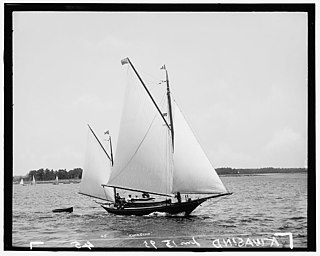
Elbridge T. Gerry was a 19th-century New York Sandy Hook pilot boat built in 1888 at the Robinson & Waterhouse shipyard in City Island, Bronx. She was named in honor of Elbridge Thomas Gerry, a commodore of the New York Yacht Club. She served as a pilot boat from 1888 to 1896, when she was sold for offshore yachting cruises. Her name was changed to Kwasind, after the strongman in Henry Wadsworth Longfellow's Song of Hiawatha.



















